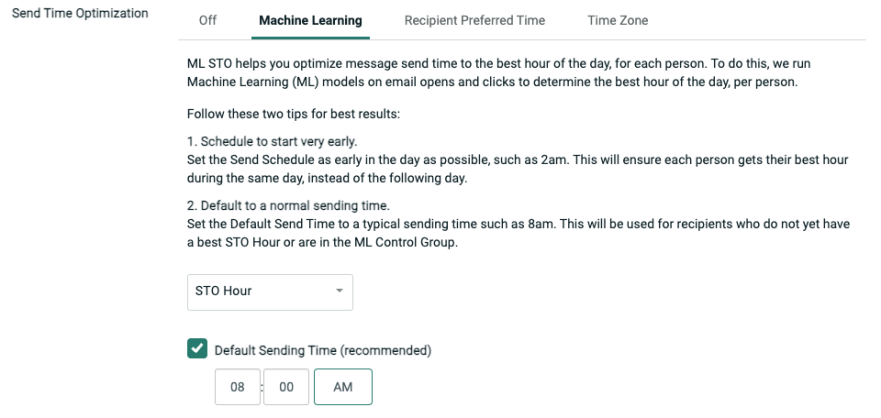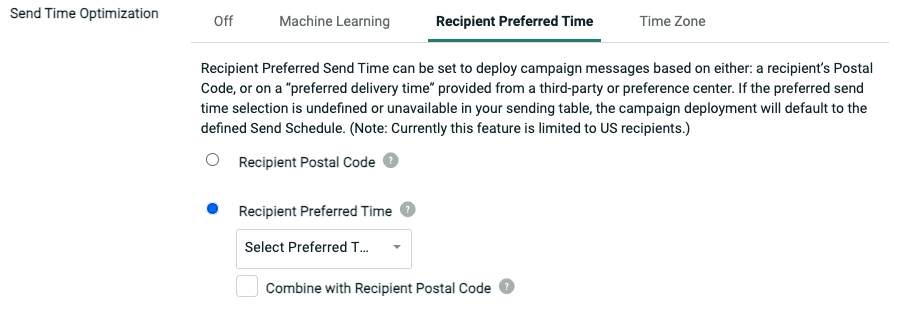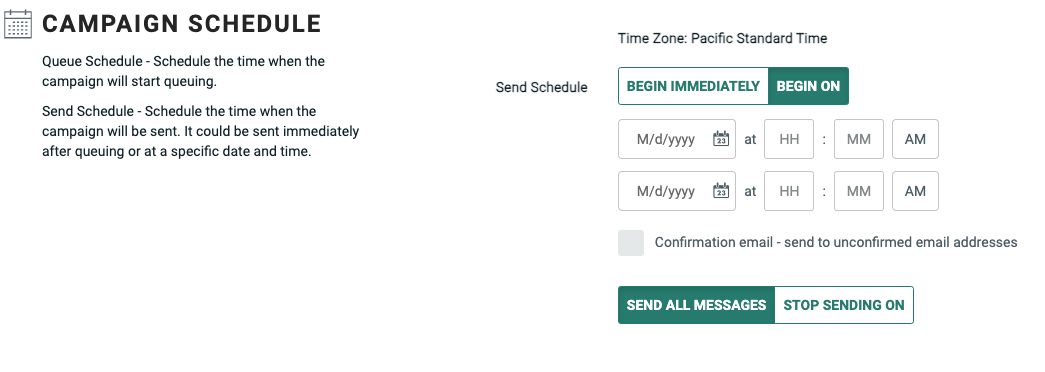Schedule a Regular One-off Campaign
When building an Email Campaign, MarigoldEngage+ supports two different data sources:
-
A table in the Engage+ database
-
The Engagement Data Platform (EDP)
As described below, the Campaign scheduling options vary slightly between the two data sources.
Scheduling Options
For a Regular One-off Campaign that uses a Engage+ table at its data source, the Campaign progresses through two distinct phases after it's launched: building messages (often referred to as "queueing") and sending messages. Each of these phases is controlled by its own dedicated schedule that defines when to start the schedule for that phase.
The Queue Schedule controls the message building phase. By default, the Queue Schedule is set to "Begin Immediately," meaning as soon as the Campaign is launched.
The Send Schedule controls the message sending phase. It defaults to prompting you to enter a start date / time. You must either enter this date / time, or switch the Send Schedule to begin as soon as messages are built. In this manner, you can't accidentally launch a Campaign with the default settings in place.
1. Schedule a Campaign to build and send immediately
1. Navigate to the Campaign and select the Review tab.
2. In the Campaign Schedule area, select Begin Immediately and Start After Queuing

2. Schedule a Campaign to build in the future
You can delay the Queue Schedule to some point in the future, after the Campaign is launched.
1. Navigate to the Campaign and select the Review tab.
2. In the Campaign Schedule area, next to Start After Queueing, select Start On.
-
Select Date from the drop-down menu, and enter the date and time to begin building messages.

3. Next to Send Schedule, either:
• Click Start after Queuing to begin deploying messages immediately after they're built.
• Or, click Start on, and enter the date / time to begin deploying messages.
Note: The Queue Schedule start date / time must be before the Send Schedule start date / time.
3. Stop a Send Schedule
By default, a Regular One-off Campaign will continue running until all messages have been deployed. Optionally, you can define a date / time to stop the Send Schedule.
-
Navigate to the Campaign and select the Review tab.
-
Beneath Send Schedule, click Advanced Options to expand this section.
-
Click Stop Sending On, and enter the date / time to stop deploying messages.

4. Define a Sending Frequency and / or Window
By default, the platform will send messages every day, all day long, until all the messages have been sent. You can define a daily Sending Window, and the platform will send messages only during this Sending Window. You can also define daily or weekly sending frequencies.
1. Navigate to the Campaign and select the Review tab.
2. Beneath Send Schedule, click Advanced Options to expand this section.
3. Define the sending frequency:
-
Daily: Enter an interval (every "X" days).
-
Weekly: Select one or more days of the week.
4. Select the Send Only Between tab.
5. Enter the start and end times of the Sending Window.

Note: If the Campaign doesn't complete the sending process during the Sending Window, the remaining recipients will stay held in the queue until the next window.
Send Time Optimization
Send Time Optimization (STO) allows you to derive the best time to contact each recipient within the Campaign's audience.
Marigold Engage+ will deploy messages to each recipient based on their preferred time of day. The platform will hold messages in the queue until the recipient's preferred send time is reached, which may cause the total Campaign deployment to take longer. As an example, let's say you launch a Campaign at 11:00 AM, and a recipient has a preferred send time of 8:00 AM. The platform will hold this message in the queue until 8:00 AM the next day, then send it.
If the STO process is unable to identify a preferred sending time for a recipient, or if STO is unsupported for a recipient, the platform will revert to using the Send Schedule defined for the Campaign, or to using the Default Sending Time (described below) if one is defined.
Engage+ supports several options for Send Time Optimization, each of which are described below.
5. Machine Learning
ML Recommended Time utilizes Machine Learning models based on click and open data to determine the optimal delivery time based on recipient behavior and email engagement.
-
Navigate to the Campaign, and select the Review tab.
-
Next to Send Time Optimization, select the Machine Learning tab.
-
From the drop-down menu, select the recipient activity field on which you want to base the Send Time Optimization.
-
Optionally, check Default Sending Time and enter a time. The Default Sending Time applies to Control Group recipients and all recipients where the platform was unable to derive a Recommended Time.

6. Postal Code
The Postal Code option uses a Postal Code field to optimize Campaign deployment based on each recipient's local time. To use this feature, the Campaign's source table must have a dedicated Postal Code field.
-
Navigate to the Campaign, and select the Review tab.
-
Next to Send Time Optimization, select the Recipient Preferred Time tab.
-
Select the Recipient Postal Code radio button.
-
From the drop-down menu, select the desired Postal Code field.

7. Recipient Preferred Time
The Recipient Preferred Time option lets you optimize Campaign deployment based on data imported into the platform from a third-party source. The Preferred Time must be stored in a Date / Time field. The platform will consider only the hour component of the Date / Time value; the date, minute, and second components are ignored.
-
Navigate to the Campaign, and select the Review tab.
-
Next to Send Time Optimization, select the Recipient Preferred Time tab.
-
Select the Recipient Preferred Time radio button.
-
From the drop-down menu, select the field in the Engage+ table that contains the preferred time data.
-
Optionally, check Combine with recipient Postal Code, then select a Postal Code field that you want to use to derive each recipient's time zone.

8. Time Zone
The Time Zone option uses a time zone field to optimize Campaign deployment based on each recipient's local time. To use this feature, the Campaign's source table must have a dedicated time zone field.
-
Navigate to the Campaign, and select the Review tab.
-
Next to Send Time Optimization, select the Time Zone tab.
-
From the drop-down menu, select the desired time zone field.

EDP Campaigns
Campaigns that use EDP as the data source utilize a different flow than Campaigns that use a Engage+ table as the data source. Because of this different flow, the concept of an "advance queue" (that is, queueing email messages up for some period of time prior to deployment) is not supported in EDP-driven Campaigns. Therefore, you can't define separate schedules for the message building phase and for the message sending phase, as you can for Campaigns built off a Engage+ table. Instead, you must define a single Send Schedule, which encompasses both phases.
9. Define the Send Schedule
To define the Send Schedule for an EDP-driven Campaign:
Navigate to the Campaign, and select the Review tab.
Next to Send Schedule, select either:
-
Begin Immediately: Start building and sending messages immediately when the Campaign is launched (this option is selected by default).
-
Begin On: Start building and sending messages at the specified date / time.

